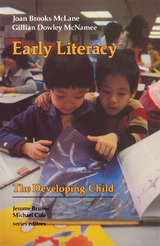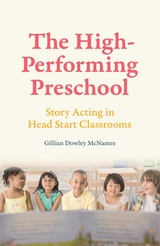
Four-year-old Joshua challenges his father to a game: Can he come downstairs before Joshua writes the word to? Rachel, two and a half, makes a series of wavy lines on a piece of paper and calls it a “thank-you letter to Grandma.” In Early Literacy Joan McLane and Gillian McNamee explore the ways young children like Joshua and Rachel begin to learn about written language. Becoming literate requires mastering a complex set of skills, behaviors, and attitudes that makes it possible to receive and communicate meaning through the written word. McLane and McNamee provide a fresh examination of this process in light of recent research.
The authors look closely at what young children do with writing and reading. As children play with making marks on paper and listen to stories being read aloud, they begin to discover uses and purposes for written language. They learn that they can use writing to communicate with people they care about and that reading story books opens up new ideas and experiences. As children experiment with writing and reading in their talking, drawing, and pretend play, they can build “bridges to literacy.”
The authors emphasize the importance of children's relationships with significant adults and peers for growth in literacy. They also devote chapters to early literacy development at home and in the neighborhood, and in preschool and kindergarten settings. In one daycare center for inner-city children, for example, where a favorite activity is dictating and acting out stories, children become active participants in a community of readers and writers—a literate culture.
Through its clear and concise discussion of young children's growth toward literacy, and its examples of the contexts that encourage and enrich that growth, Early Literacy will serve as a valuable resource for parents, teachers, and others who work or play with young children.

McNamee outlines how story acting cultivates children’s oral and written language skills. She shows how it creates a crucial opportunity for teachers to guide children inside the interior logic and premises of an idea, and how it fosters the creation of a literary community. Starting with Vygotsky and Paley, McNamee paints a detailed portrait of high-quality preschool teaching, showing how educators can deliver on the promise of Head Start and provide a setting for all young children to become articulate, thoughtful, and literate learners.
READERS
Browse our collection.
PUBLISHERS
See BiblioVault's publisher services.
STUDENT SERVICES
Files for college accessibility offices.
UChicago Accessibility Resources
home | accessibility | search | about | contact us
BiblioVault ® 2001 - 2024
The University of Chicago Press









